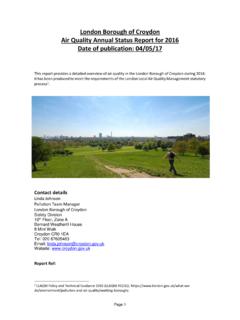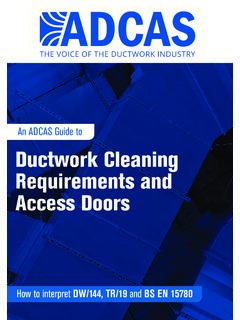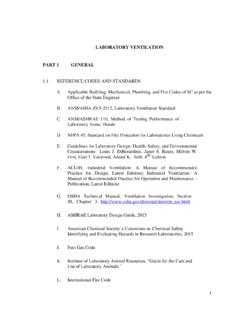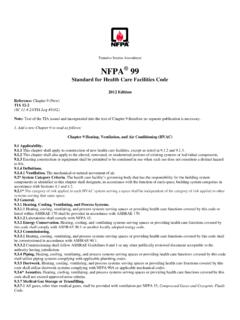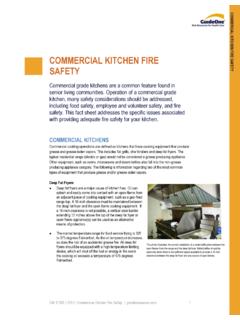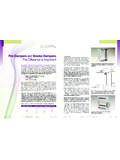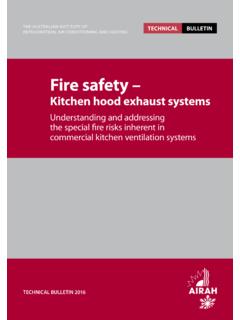Transcription of Requirements for extraction/ventilation systems
1 Planning Applications: Food and Drink Premises (A3/A4/A5). Requirements for extraction / ventilation systems Pollution Team The purpose of this Guidance Note is to explain what the Council's Requirements are in relation to the environmental aspects (odour/fumes/noise) of planning applications for premises in Class A3/A4/A5. Class A3/A4/A5 use is the sale of food and drink for consumption on the premises or of hot food for consumption off the premises. It therefore covers most restaurants, cafes, pubs and hot food take- aways. A separate Guidance Note on the Design and Construction of Catering Establishments ( ) gives a wide range of information and advice on the structural design of catering businesses and the facilities required to comply with food hygiene legislation. Copies of this Guidance Note are available from the Community Services Department by using the contact details at the end of this note.
2 Introduction When a planning application in relation to food or drink premises is received by the Council, an environmental assessment of the application is carried out by the Pollution Service. The aim of the assessment is to ensure that the proposed development has an adequate ventilation system that will not lead to complaints from neighbouring properties about cooking smells or noise from equipment such as fan motors. Other environmental issues are also considered, such as the likelihood of disturbance to neighbours by customers late at night. The Council has powers under the Environmental Protection Act 1990 to take action against restaurants, take-aways and other food and drink premises if they cause a nuisance. However, it is much better for the relevant details to be incorporated into planning applications to ensure that such problems are unlikely to occur.
3 How to use this Guidance Note This Note explains the elements of a good extraction / ventilation system for an A3/A4/A5 premises, and describes the things we will be looking for and why. If you have an architect or agent, you may wish to pass a copy of the Guidance Note on to them so that the necessary details can be built into your plans if they are not already included. Are all of the Requirements necessary? In most cases we will ask for all of the details in this Guidance Note to be incorporated into an extraction / ventilation system for an A3/A4/A5 use, regardless of the type of food to be cooked. This is because, once planning permission is granted for this, the premises can be used for any range of food preparation, including those which have the potential to cause odours. If you are concerned about the need for all of the Requirements set out in this Guidance Note to be included in your application, it may be possible for the planning consent to restrict the types of food you can cook on the premises.
4 If this is the case, please contact the Planning Officer dealing with your application see end of note for contact details. Best practice for design and operation of commercial kitchen ventilation systems : performance Requirements extraction / ventilation systems Adequate ventilation / extraction must be provided in food and drink premises to remove steam, cooking odours and grease-laden air. In most cases, natural ventilation is insufficient and an extract duct with a fan and filters is required to ventilate cooking fumes and remove odours without causing a nuisance to neighbouring properties. Getting the right ventilation / extraction system for your needs can be rather complex, and should contact a specialist contractor who can carry out a ventilation survey for you, or advise you on a specific aspect of your Requirements .
5 A separate Guidance Note containing contact details of companies who are able to undertake ventilation surveys is available from the Food team by using the contact details at the end of this note. Please ask for Guidance Note Please note, however, that the companies listed in Guidance Note are solely for information only. Their inclusion in the list does not form any endorsement by the Council. Minimum ventilation rates An internal ambient air temperature of 280C maximum. Maximum humidity levels of 70%. Internal noise level should be between NR40 NR50. Dedicated make up air system to be approximately 85% of the extract flow rate Minimum air change rate of 40 per hour (bases on canopy and general room extraction ). Minimum Requirements for canopy Velocity Requirements Light loading m/s (applies to steaming ovens, boiling pans, bains marie and stock-pot stoves).
6 Medium loading m/s (applies to deep fat fryers, bratt pans solid and open top ranges and griddles). Heavy loading m/s (applies to chargrills, mesquite and specialist broiler units). Material of construction A material that would comply with the food hygiene requirement is stainless steel Grease filtration Have a minimum performance the same as a baffle filter Be easy to clean Ducting As a general rule, ducting should be as straight and short as possible, to ensure that fumes are discharged as effectively as possible. Care should be taken when designing the route of ducting to avoid proximity to residential or office windows on neighbouring properties, which could give rise to complaints. Ducting systems should extend to at least one metre higher than the eaves of the property. In some cases we may ask for the top of the extract duct to discharge in a certain direction in order to minimise the likelihood of complaints.
7 Ducting should not be routed through residential rooms. Ductwork should be fitted with anti-vibration mountings to minimise the vibration caused by air passing through. Even if you are applying for planning permission only for external ducting, it is important to remember that vibration from the ductwork inside the building could also cause a nuisance to adjacent domestic or residential properties, particularly if ducting is fixed to a ceiling or party wall. Anti-vibration mountings should be used for all ductwork fixings. Minimum Requirements for ductwork All ductwork should be Low Pressure Class A' and constructed in accordance with HVCA Specification DW/144[1] with a minimum thickness of Duct should be as follows: Supply (m/s) Extract (m/s). o Mains run 6-8 6-9. o Branch runs 4-6 5-7. o Spigots 3-5 5-7.
8 All internal surfaces of the ductwork should be accessible for cleaning and inspection. Access panels should be installed at centres and should be grease tight using a heat proof gasket or sealant. Duct work should not pass through fire barriers Where it is not possible to immediately discharge the captured air, fire rated ductwork may be required. Minimum Requirements for Odour Control Discharge stack The discharge stack should: 1. Discharge the extracted air not less than 1 m above the roof ridge of any building within 20 m of the building housing the commercial kitchen 2. If 1 cannot be complied with for planning reasons, then the extracted air shall be discharged not less than 1 m above the roof eaves or dormer window of the building housing the commercial kitchen. Additional odour control measures may be required 3.
9 If 1 or 2 cannot be complied with for planning reasons, then an exceptionally high level of odour control will be required Low level discharge should be avoided. Use of Chinaman's hats or other cowls is not recommended Filters Various types of filters will usually be required in order to eliminate grease and odours from the cooking fumes Grease filters Grease filters ensure that grease is removed from the cooking fumes. This helps prevent it from building up inside the ducting, which can cause hygiene and odour problems, cause the grease to leak through joints in the ductwork, and pose a fire risk. Grease filters should be incorporated into the cooker hood and should be easily removable for cleaning before they become clogged. Proper maintenance of grease filters is essential, as grease accumulation further up the ventilation ducting can be very difficult to remove.
10 When fitting grease filters, mesh type filters are preferable to baffle type filters as they are considered to be more effective. Carbon and Pre-filters Carbon filters are also required and are essential when preparing fried foods and/or foods with strong odours in a food premises close to residential or office properties. Properly maintained carbon filters can eliminate the majority of odours created when food is cooked. Carbon filters should be fitted internally to the ductwork, after the grease filters, and should be positioned so that they can easily be accessed for cleaning. The carbon filter unit you select should include pre-filters, as these help ensure that no grease enters the carbon filters themselves. Carbon filters can be ruined by operating the extraction system without effective removal of grease.


